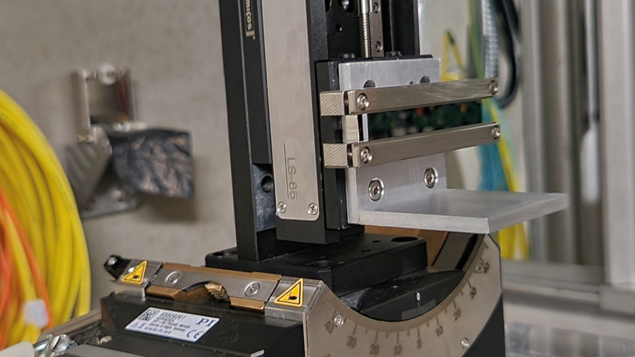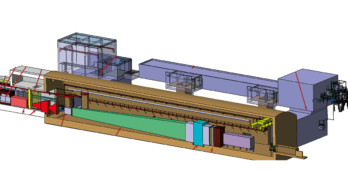
The Physics Beyond Colliders (PBC) initiative has diversified the landscape of experiments at CERN by supporting smaller experiments and showcasing their capabilities. Its fifth annual workshop convened around 175 physicists from 25 to 27 March to provide updates on the ongoing projects and to explore new proposals to tackle the open questions of the Standard Model and beyond.
This year, the PBC initiative has significantly strengthened CERN’s dark-sector searches, explained Mike Lamont and Joachim Mnich, directors for accelerators and technology, and research and computing, respectively. In particular, the newly approved SHiP proton beam-dump experiment (see SHiP to chart hidden sector) will complement the searches for light dark-sector particles that are presently conducted with NA64’s versatile setup, which is suitable for electron, positron, muon and hadron beams.
First-phase success
The FASER and SND experiments, now taking data in the LHC tunnel, are two of the successes of the PBC initiative’s first phase. Both search for new physics and study high-energy neutrinos along the LHC collision axis. FASER’s successor, FASER2, promises a 10,000-fold increase in sensitivity to beyond-the-Standard Model physics, said Jonathan Feng (UC Irvine). With the potential to detect thousands of TeV-scale neutrinos a day, it could also measure parton distribution functions and thereby enhance the physics reach of the high-luminosity LHC (HL-LHC). FASER2 may form part of the proposed Forward Physics Facility, set to be located 620 m away, along a tangent from the HL-LHC’s interaction point 1. A report on the facility’s technical infrastructure is scheduled for mid-2024, with a letter of intent foreseen in early 2025. By contrast, the CODEX-b and ANUBIS experiments are being designed to search for feebly interacting particles transverse to LHCb and ATLAS, respectively. In all these endeavours, the Feebly Interacting Particle Physics Centre will act as a hub for exchanges between experiment and theory.
Francesco Terranova (Milano-Bicocca) and Marc Andre Jebramcik (CERN) explained how ENUBET and NuTAG have been combined to optimise a “tagged” neutrino beam for cross-section measurements, where the neutrino flavour is known by studying the decay process of its parent hadron. In the realm of quantum chromodynamics, SPS experiments with lead ions (the new NA60+ experiment) and light ions (NA61/SHINE) are aiming to decode the phases of nuclear matter in the non-perturbative regime. Meanwhile, AMBER is proposing to determine the charge radii of kaons and pions, and to perform meson spectroscopy, in particularwith kaons.
The LHCspin collaboration presented a plan to open a new frontier of spin physics at the LHC building upon the successful operation of the SMOG2 gas cell that is upstream of the LHCb detector. Studying collective phenomena at the LHC in this way could probe the structure of the nucleon in a so-far little-explored kinematic domain and make use of new probes such as charm mesons, said Pasquale Di Nezza (INFN Frascati).
Measuring moments
The TWOCRYST collaboration aims to demonstrate the feasibility and the performance of a possible fixed-target experiment in the LHC to measure the electric and magnetic dipole moments (EDMs and MDMs) of charmed baryons, offering a complementary probe of searches for CP violation in the Standard Model. The technique would use two bent crystals: the first to deflect protons from the beam halo onto a target, with the resulting charm baryons then deflected by the second (precession) crystal onto a detector such as LHCb, while at the same time causing their spins to precess in the strong electric and magnetic fields of the deformed crystal lattice, explained Pascal Hermes (CERN).
New ideas ranged from the measurement of molecular electric dipole moments at ISOLDE to measuring the gravitational field of the LHC beam
Several projects to detect axion-like particles were discussed, including a dedicated superconducting cavity for heterodyne detection being jointly developed by PBC and CERN’s Quantum Technology Initiative. Atom interferometry is another subject of common interest, with PBC demonstrating the technical feasibility of installing an atom interferometer with a baseline of 100 m in one of the LHC’s access shafts. Other new ideas ranged from the measurement of molecular EDMs at ISOLDE to measuring the gravitational field of the LHC beam.
With the continued determination to fully exploit the scientific potential of the CERN accelerator complex and infrastructure for projects that are complementary to high-energy-frontier colliders testified by many fruitful discussions, the annual meeting concluded as a resounding success. The PBC community ended the workshop by thanking co-founder Claude Vallée (CPPM Marseille), who retired as a PBC convener after almost a decade of integral work, and welcomed Gunar Schnell (Ikerbasque and UPV/EHU Bilbao), who will take over as convener.





